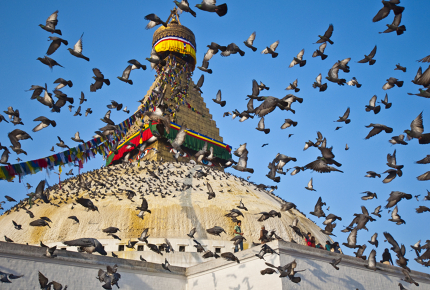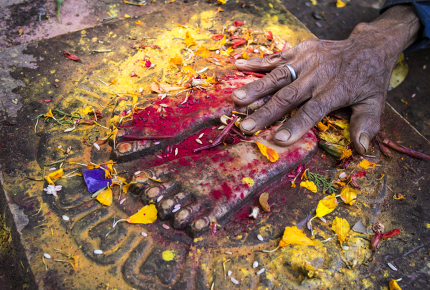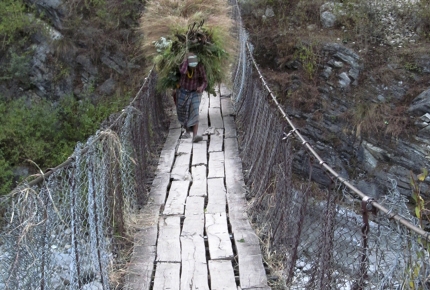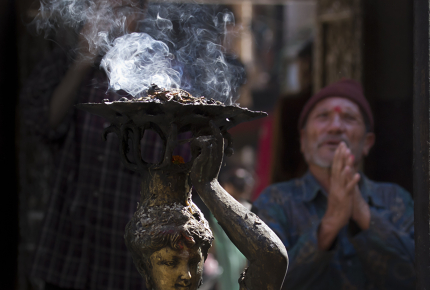Navigating Nepal, now the dust has settled
Two months after catastrophic earthquakes devastated communities and brought sacred landmarks to the ground, Ruth-Ellen Davis looks at whether it’s time to go back to Nepal.
From the moment the plane descends enough to see the jagged Himalayas thundering skywards behind Kathmandu, Nepal has you transfixed.
Months after leaving, my head was still swept up in the tiny, mountainous country; the slightest wisp of cloud became a snowcapped peak imprinted on the East London horizon.
But more than glorious memories of rising temples, descending lush green rice terraces and strings of fluttering prayer flags illuminated by the sunrise, it was the unending kindness and gentle spirituality of the Nepalese people that made the news of the devastating 7.8 magnitude earthquake on 25 April, and the subsequent 7.3 tremor on 12 May, so wholly difficult to bear.
There’s no two ways about it: Nepal needs its visitors back. Reports say tourism is down as much as 90%, and in a country where over half the population work in the industry, its hopes of recovery depend on some semblance of normal daily life returning.
 Following the earthquake, is it safe to visit Nepal?
Following the earthquake, is it safe to visit Nepal?filmlandscape / Thinkstock
Is it safe to return to Nepal?
Travel advice since the quakes has been conflicting. Within weeks, embassies in Nepal announced that the country was open for business, despite scenes of desperate devastation being televised around the globe. Until very recently, the official advice from Britain and the US was to avoid travelling to the country unless absolutely necessary – a stringent stance, seeing only 14 of Nepal’s 75 districts suffered any damage.
At the time of going to print, the UK’s Foreign and Commonwealth Office is still advising against all but essential travel to just over a third of Nepal, “a decision that’s not taken lightly”, they say.

Sangram’s story: surviving Nepal's earthquake
A Nepalese guide recounts his experience of the deadly April earthquake and provides an insight into how residents are coping with the aftermath.
This covers popular areas like Everest Base Camp, though visitors will still find many of the magnificent trekking trails, peaceful mountainsides and welcoming communities as they were before the earthquakes.
“Most trekking routes are open and Kathmandu Valley has been cleaned up considerably,” says Ravi Kumar, co-founder of not-for-profit Code for Nepal, a digital literacy company that mapped the country’s deaths and injuries following the quakes. “And then there are places almost entirely unaffected by the earthquakes, such as lakeside town Pokhara, which are continuing as normal.”
 Nepal's recovery will depend on normal daily life returning
Nepal's recovery will depend on normal daily life returningRattham / Thinkstock
Pokhara, sat beside Phewa Lake, is ideal for those keen to visit Nepal in the coming months. With its mountain views, boat trips, paragliding, yoga retreats and lively restaurants, this friendly and bohemian town offers plenty for the visitor.
Pokhara is also the gateway to the greenly furnished Annapurna region, Nepal’s most popular trekking destination, with its forested vistas, tumbling waterfalls and manageable routes.
The Annapurna Base Camp trek (often referred to as the ABC) follows a 10-day loop that winds through leafy jungle and peaceful mountain towns, including a pre-sunrise hike for symphony-worthy views of the sun coming up over the Himalayas. It even factors in a good soak in natural hot springs. It’s an accessible trip, with trekkers on foot for around five hours a day. The dramatic mountain vistas along the way are more commonly associated with far more challenging expeditions.
“The Annapurna region is a paradise for trekkers and offers a great introduction to trekking,” says Jennifer Parker from Rickshaw Travel.
“The route here is easier than that on Everest, and you're rewarded with sweeping views and stirring sunrises – not to mention plenty of apple pies!”
But mountainous peaks are certainly not Nepal’s only draw. One of the many Nepalese destinations completely unaffected by the earthquakes is Chitwan National Park, a tranquil haven of calm that’s worth the airfare itself.
Wildlife here includes the one-horned rhino and, if you’re lucky, the Bengal tiger. Visitors can look out from luxury lodges or camp out in the bunks of humble park ranger watchtowers for the chance to see rhinos grazing in the moonlight.
 Most trekking routes in Nepal are now open
Most trekking routes in Nepal are now opengoosey270 / Thinkstock
Visiting Kathmandu
Those arriving in Nepal by air should spend some time in Kathmandu. The temples of the Nepalese capital have long attracted crowds, but the city was hit hard during the earthquakes and sights like the Bhimsen Tower have been reduced to little more than rubble.
However, many of the temples and monuments damaged by the quakes have been declared safe and have now reopened. Still, UNESCO has expressed concern and “reminds the general public to be extra cautious” when visiting affected sites in the city, especially Swayambhunath (known locally as the Monkey Temple) and Kathmandu’s Durbar Square, which the agency is reevaluating.
“The Durbar squares of Kathmandu, Bhaktapur and Patan are all badly damaged, but most of the debris has now been removed,” says Jennifer at Rickshaw. “It does mean, however, that these areas now look more like temple ruins rather than temples.”
Despite that, Kathmandu still offers many things to see and do. There are countless historic buildings and temples that escaped unscathed. Hotels and restaurants are open, especially in tourist hub Thamel, and your custom will be greatly received.
“One of the best ways visitors can help is to pay good tips to maids, waiters and taxi drivers,” says Ravi Kumar. “These frontline workers often don't get paid well by the business owners, and a good tip can make such a difference to them – specially now. This is a great way to help Nepal at the moment.”
 Kathmandu still offers many things to see and do
Kathmandu still offers many things to see and doUtopia_88 / Thinkstock
NEED TO KNOW
Getting there
There are no direct flights from the UK to Nepal, but Qatar Airways, Oman Air and Etihad all fly to Tribhuvan International Airport in Kathmandu via Doha, Muscat and Abu Dhabi, respectively. Prices start from £495.
Getting around
Brighton’s Rickshaw Travel (www.rickshawtravel.co.uk) offers bespoke trips around Nepal, which can take in Kathmandu, Pokhara and the wider Annapurna region, plus Chitwan National Park.
More information
Nepal Tourist Board: www.welcomenepal.com
Do you have any Feedback about this page?
© 2025 Columbus Travel Media Ltd. All rights reserved. No part of this site may be reproduced without our written permission, click here for information on Columbus Content Solutions.









 You know where
You know where